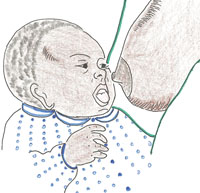10.3.2 Improving positioning and attachment
If in your assessment of breastfeeding you found any difficulty with attachment or suckling, you can help the mother position and attach her infant better. Make sure that the mother is comfortable and relaxed, for example, sitting on a low seat with her back straight. Then follow the steps in Box 10.1.

Box 10.1 Teach correct positioning and attachment for breastfeeding
- Show the mother how to hold/position her infant:
- with the infant’s head and body straight
- facing her breast, with the infant’s nose opposite her nipple
- with the infant’s body close to her body
- supporting the infant’s whole body, not just the neck, shoulder and head.
- Show the mother how to help the infant to attach. She should:
- touch her infant’s lips with her nipple
- wait until her infant’s mouth is opening wide (see Figure 10.8)
- move her infant quickly onto her breast, aiming the infant’s lower lip well below the nipple.
- Look for signs of good attachment and effective suckling. If the attachment or suckling is not good, ask the mother to try again.
Always observe a mother breastfeeding before you help her, so that you understand her situation clearly. Do not rush to make her do something different. If you see that the mother needs help, first say something encouraging, like:
‘She really wants your breastmilk, doesn’t she?’
Then explain what might help and ask if she would like you to show her. For example, say something like:
‘Breastfeeding might be more comfortable for you if your baby took a larger mouthful of breast. Would you like me to show you how?’
If she agrees, you can start to help her.
As you show the mother how to position and attach the infant, be careful not to take over from her. Explain and demonstrate what you want her to do. Then let the mother position and attach the infant herself.
Then look for signs of good attachment and effective suckling again (see Figure 10.8). If the attachment or suckling is not good, ask the mother to remove the infant from her breast and to try again. When the infant is suckling well, explain to the mother that it is important to breastfeed long enough at each feed, and to empty one breast before switching to the other. She should not stop the breastfeeding before the infant wants to stop.
10.3.1 Reasons for poor attachment and ineffective suckling
